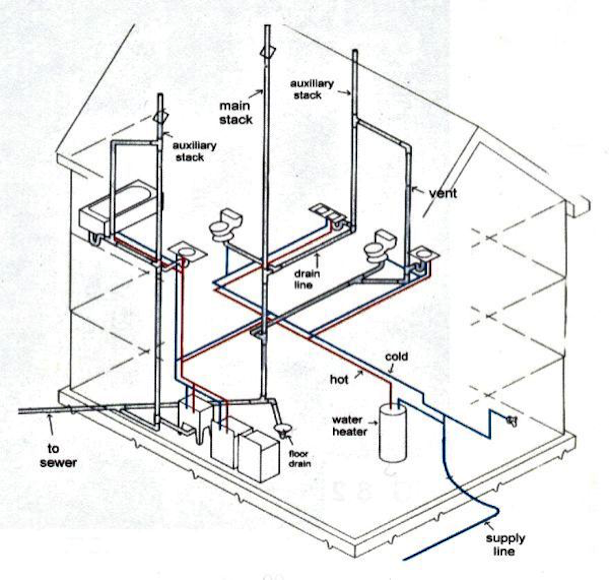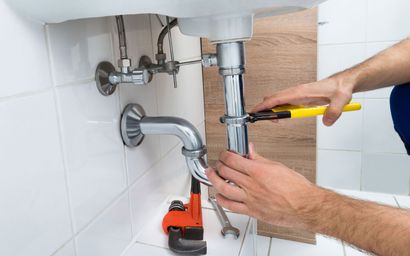The Essential Elements of Your Property's Plumbing System
The Essential Elements of Your Property's Plumbing System
Blog Article
How do you actually feel on the subject of Exploring Your Homes Plumbing Anatomy?

Understanding how your home's plumbing system functions is important for every single property owner. From providing clean water for drinking, cooking, and showering to securely getting rid of wastewater, a properly maintained pipes system is critical for your family members's wellness and convenience. In this comprehensive guide, we'll discover the detailed network that makes up your home's plumbing and deal ideas on upkeep, upgrades, and handling common issues.
Intro
Your home's pipes system is greater than just a network of pipes; it's a complicated system that guarantees you have access to clean water and reliable wastewater elimination. Understanding its parts and exactly how they collaborate can aid you prevent pricey repair services and ensure whatever runs efficiently.
Fundamental Components of a Plumbing System
Pipelines and Tubes
At the heart of your plumbing system are the pipelines and tubing that lug water throughout your home. These can be constructed from different products such as copper, PVC, or PEX, each with its benefits in regards to toughness and cost-effectiveness.
Components: Sinks, Toilets, Showers, etc.
Fixtures like sinks, commodes, showers, and bath tubs are where water is used in your house. Comprehending how these fixtures attach to the pipes system helps in detecting problems and planning upgrades.
Valves and Shut-off Points
Shutoffs control the circulation of water in your plumbing system. Shut-off shutoffs are crucial during emergencies or when you require to make fixings, permitting you to isolate parts of the system without disrupting water circulation to the whole house.
Water Supply System
Key Water Line
The primary water line attaches your home to the municipal water supply or a personal well. It's where water enters your home and is dispersed to numerous components.
Water Meter and Pressure Regulatory Authority
The water meter measures your water usage, while a stress regulatory authority guarantees that water streams at a safe stress throughout your home's plumbing system, avoiding damage to pipes and components.
Cold Water vs. Warm water Lines
Comprehending the difference between cold water lines, which supply water directly from the primary, and warm water lines, which lug warmed water from the hot water heater, helps in troubleshooting and planning for upgrades.
Water drainage System
Drain Pipeline and Traps
Drain pipes bring wastewater far from sinks, showers, and bathrooms to the drain or septic system. Traps stop drain gases from entering your home and also trap debris that could create blockages.
Air flow Pipes
Air flow pipes enable air right into the drain system, stopping suction that can reduce drainage and cause traps to vacant. Correct ventilation is important for keeping the integrity of your plumbing system.
Value of Proper Drain
Making certain correct drain avoids back-ups and water damage. Frequently cleaning up drains pipes and keeping catches can stop expensive repair services and prolong the life of your plumbing system.
Water Heating Unit
Types of Water Heaters
Hot water heater can be tankless or traditional tank-style. Tankless heating units warmth water as needed, while storage tanks keep heated water for prompt usage.
Upgrading Your Pipes System
Factors for Updating
Updating to water-efficient components or changing old pipes can improve water top quality, reduce water expenses, and increase the value of your home.
Modern Plumbing Technologies and Their Benefits
Check out innovations like clever leakage detectors, water-saving bathrooms, and energy-efficient water heaters that can conserve money and reduce environmental impact.
Expense Factors To Consider and ROI
Compute the upfront costs versus long-lasting savings when considering plumbing upgrades. Numerous upgrades spend for themselves through reduced energy costs and fewer fixings.
How Water Heaters Link to the Plumbing System
Recognizing just how hot water heater link to both the cold water supply and warm water circulation lines aids in detecting issues like inadequate hot water or leakages.
Maintenance Tips for Water Heaters
Routinely purging your hot water heater to remove debris, inspecting the temperature level settings, and checking for leakages can prolong its lifespan and improve energy effectiveness.
Common Plumbing Issues
Leakages and Their Causes
Leakages can happen due to aging pipes, loosened installations, or high water pressure. Resolving leakages quickly protects against water damage and mold development.
Obstructions and Obstructions
Blockages in drains and toilets are frequently triggered by purging non-flushable products or an accumulation of grease and hair. Utilizing drainpipe displays and bearing in mind what decreases your drains pipes can avoid blockages.
Signs of Plumbing Problems to Expect
Low tide pressure, slow drains pipes, foul odors, or uncommonly high water expenses are signs of possible pipes problems that should be addressed immediately.
Pipes Maintenance Tips
Regular Inspections and Checks
Set up annual pipes assessments to catch concerns early. Try to find signs of leakages, rust, or mineral buildup in taps and showerheads.
DIY Upkeep Tasks
Easy jobs like cleansing faucet aerators, looking for toilet leakages utilizing color tablet computers, or insulating revealed pipes in cool environments can prevent significant pipes issues.
When to Call a Specialist Plumbing Technician
Know when a plumbing problem requires expert experience. Attempting intricate repair work without correct understanding can bring about more damages and greater repair work prices.
Tips for Decreasing Water Usage
Basic routines like fixing leaks without delay, taking shorter showers, and running full lots of laundry and dishes can save water and reduced your utility expenses.
Eco-Friendly Pipes Options
Take into consideration sustainable pipes materials like bamboo for floor covering, which is durable and environmentally friendly, or recycled glass for countertops.
Emergency Preparedness
Steps to Take Throughout a Plumbing Emergency
Know where your shut-off shutoffs lie and exactly how to shut off the supply of water in case of a burst pipe or major leak.
Relevance of Having Emergency Situation Contacts Helpful
Keep call info for local plumbers or emergency situation solutions easily offered for fast feedback during a plumbing crisis.
Environmental Influence and Preservation
Water-Saving Components and Appliances
Setting up low-flow faucets, showerheads, and commodes can considerably reduce water usage without giving up performance.
Do It Yourself Emergency Fixes (When Applicable).
Temporary repairs like making use of air duct tape to spot a dripping pipe or placing a bucket under a leaking faucet can lessen damage until an expert plumbing technician arrives.
Conclusion.
Understanding the composition of your home's pipes system encourages you to maintain it properly, saving money and time on repair services. By following routine upkeep routines and remaining informed concerning modern plumbing technologies, you can ensure your plumbing system operates effectively for years to find.
HOW YOUR PLUMBING SYSTEM WORKS
Which Pipes Do What?
Blue lines = fresh water supply entering the building Red lines = hot water supply entering the building Grey lines = pipes carrying waste away from the building and venting pipes carrying gases away from the building (through the roof) YOUR MAIN PLUMBING SYSTEMS
There are two main plumbing systems that support your home s basic plumbing needs one that brings clean water into your home, and one that sends dirty water away from your home. Connected to the toilet, bath, shower, and other faucets in your home, these two systems keep your water flowing in the right directions.
ACCESSING FRESH WATER
Fresh and clean water is brought into your home through the main water supply line . Filtered through one pipe, this water is pressured to flow into the various fixtures in your home at any given time.
This water can be sourced from a well located on your property, a pond or river (mostly cottages), or, as in most cases, from the city s municipal water treatment centre. However, it is important to note that water that is untreated, such as the water siphoned from ponds or rivers, may not be safe to drink. Personal water supplies always need to be treated for hardness and contaminants before consumed.
MUNICIPAL WATER SUPPLIES
Improve taste and odour Remove sediment Eliminate hardness Reduce chlorine COLD WATER SUPPLY VS. HOT WATER SUPPLY
Cold water flows into your home or building through the service line, which then distributes hot or cold water to your fixtures. This line is most commonly run through a central column that runs floor to floor. Hot water runs in short and straight pipes as the longer the pipeline, the more heat that will be lost in the transfer. Having shorter pipes also allows residents to access hot water more quickly.
WASTE WATER SYSTEM
Your wastewater system is divided into two parts pipes that send wastewater away from your home and venting pipes that send sewer gas away from your home. Sewage water travels through pipes that flush the water and waste towards local sewers that are operated and managed by your city or town. Most sewer systems rely on gravity to move the wastewater to where it needs to go.
The further away from your toilet or sink, the larger wastewater pipes become. This allows for waste to be disposed of from various parts of your home or business at once without pipe blockages. The angle and flow of these pipes are also essential for keeping your waste pipes clear of build up.
https://harrisplumbing.ca/how-your-home-plumbing-system-works/

Do you appreciate reading about Exploring Your Homes Plumbing Anatomy? Put feedback down below. We will be glad to know your insights about this content. Hoping to see you back again in the near future. Please set aside a second to promote this post if you enjoyed it. We recognize the value of reading our article about Anatomy of a House: Understanding the Components.
Book With Us Today! Report this page